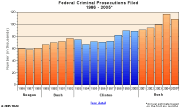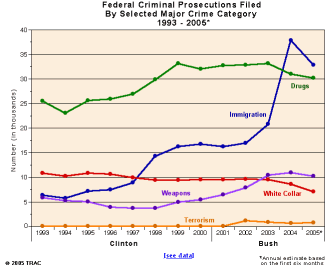Immigration and Weapons Enforcement Up, White Collar and Drug Prosecutions Slide
A case-by-case study of more than half a million individual federal prosecutions by the Transactional Records Access Clearinghouse (TRAC) has documented significant shifts in how the federal government enforced the law during the first term of President Bush.
The Justice Department records obtained by TRAC under the Freedom of Information Act show two broad sorts of change: a large increase in the overall number of cases being prosecuted each year by the government and dramatic shifts in the kinds of matters it brought to court.

Figure 1: Click for larger image |
From FY 2000 to FY 2004, for example, federal criminal cases increased by
more than 31% continuing a long term trend. And even more timely information concerning criminal
enforcement activities during the first six months of FY 2005 indicates that, although decreased from 2004 levels, the
upward surge is so far continuing in President Bush's second term. (See Figure 1 and supporting table.)
Changing Make Up of the Cases
The analysis of the information compiled on a month-by-month basis by the U.S. Attorneys in charge of federal enforcement in each of the 90 federal districts within the United States also documents how the composition of the criminal cases brought by government has been transformed. Prosecutions aimed at some kinds of criminal problems are sharply higher, while enforcement efforts for other areas are down. Here, looking at the four crime categories with the largest number of federal prosecutions in FY 2004, are the counts:
|
|
- Immigration The individual prosecutions categorized by the U.S. Attorneys as immigration matters more than doubled from FY2000 to FY2004 -- surging from 16,724 to 37,854. This very large jump means they now make up the single largest category of federal crimes surpassing even drug prosecutions. A recent special report by TRAC found that a significant part of this increase occurred in one federal district that started filing minor criminal charges against individuals who previously had been handled by an administrative process. (See TRAC's DHS Immigration Report)
- Drugs The second largest broad category of federal criminal prosecutions in 2004 -- 30,988 of them -- concerned the enforcement of the drug laws. For this group, the filing of criminal charges leveled off during the first years of the Bush Administration and went into a decline in 2004. Estimates based on the first six months of data indicate that the decline is continuing for 2005.
- Weapons Weapons was the third largest criminal enforcement area in FY 2004. The upward trend in the prosecution of weapons matters, which started during the Clinton administration, soared during the Bush years, jumping from 5,490 in 2000 to 10,937 in 2004. In 2003, the number of weapons prosecutions surpassed the number of white collar crime prosecutions. Although the 2004 data and estimates for 2005 indicate that the upward trend may be leveling out, weapons prosecutions still outpace those aimed at curbing white collar crime.
- White Collar Crime Of the four principal groupings of federal prosecutions, the smallest concerned white collar crime violations -- 8,626 prosecutions in FY 2004. While the information from the U.S. Attorneys showed the total for these cases had remained essentially unchanged from 2000 to 2003, it documented a decline of about ten percent from FY 2003 to FY 2004. Estimates for 2005 indicate that the decline is continuing.

Figure 2: Click for larger image |
An interesting note: criminal prosecutions for terrorism related crimes appear to have declined in 2004 after peaking in 2002. It is unclear from estimates for 2005 whether or not the trend is continuing. Terrorism related prosecutions continue to be a very small part of all criminal prosecutions.
Conclusion
Federal law gives every president the authority to appoint all of the United States Attorneys, the men and women who can directly influence the kinds of cases that will be prosecuted and the kinds that will not. Given this power, and the president's direct and indirect influence on the budgets and policies of the investigative agencies, every president can put his individual stamp on the focus of federal law enforcement. In a representative democracy, this is entirely proper. What is not appropriate, however, is when the huge size and great complexity of the whole enforcement mechanism makes it very hard for Congress, news organizations, reporters and the American people to track the policies adopted by an administration. Virtually all observers agree that the lack of good information about the actual functioning of the government undermines the democratic system.